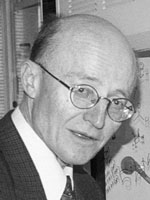
Vern Schramm
Albert Einstein College of Medicine
The Ultimate Sounding Board
My colleagues and I published our first paper on isotope effects in 1984. By that time physical organic chemistry made it clear that, in principle, transition-state structures for enzymes could be obtained. We had been inspired by a paper by the biochemist Richard Schowen on the catechol O-methyl transferase enzyme: he had used a mapping technique based on kinetic isotope effects to locate the enzyme’s transition state.
Frank Mentch was doing the computational chemistry in my lab for our first effort to obtain the transition-state structure of another enzyme, AMP nucleosidase, and we flew in a small airplane to visit Richard Schowen to get his critique of our work. Schowen invited me to speak at the Chemistry and Physics of Isotopes Conference, and I have attended every Isotopes Conference since. The conference has been the sounding board for our research on enzymatic transition-state analysis. Some of what we were doing was quite speculative, and the expertise we have been exposed to at GRC has been invaluable in critiquing and validating our approaches to enzymatic transition states.
We were soon confident that robust quantum mechanical models of enzymatic transition states were readily accessible by these methods. The logical extension of this knowledge was to design and synthesize stable molecules of the transition states. This was also surprisingly successful and yielded molecules that are powerful inhibitors and mimic the transition states.
Most recently we have been applying these principles in a logical way to design and develop new agents for human disease. The process involves selecting an enzymatic target implicated in human disease, measuring its intrinsic KIE (kinetic isotope effect), and solving its transition-state structure; using the transition-state structure to design chemically stable mimics of the transition state; synthesizing the transition-state mimics; and testing the mimics in enzymatic and biological systems. This approach has yielded a transition-state inhibitor now being tested against T-cell cancers in FDA-approved clinical trials at thirty-seven clinical sites in the Americas and Europe. A second transition-state analogue to defend against tissue transplant rejection and autoimmune diseases is also in preclinical trials. A third is in animal trials to test its effectiveness against prostate and head and neck cancers. Others are in development as agents against antibiotic-resistant bacteria.
The Isotopes Conference has been an important venue in which to preview the fundamental science of these developments. Today it is clear that KIE, enzymatic transition states, and the directed design of transition-state analogues will bear significantly in the treatment of human diseases. The conference has been an important factor in nurturing and developing this fundamental science. It is quite unexpected and surprising that in less than twenty years our basic interest in kinetic isotope effect analysis for enzymatic mechanisms has led to new agents against human diseases that are now in clinical trials.